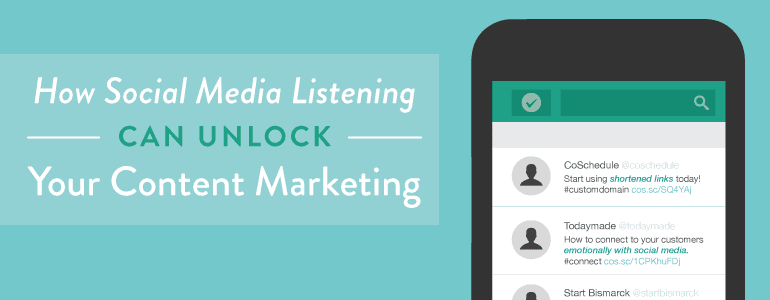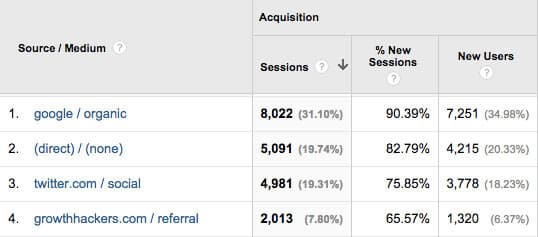
When producing content, your number one goal should be to add value for your community. That value might be sharing tactics to accomplish their goals, or lessons on how to make the best use of your product. Or it could be introducing them to tools that will make their lives easier, or even to the best restaurants in their city. No matter what your topic (aka value) is, your
content is driven by your community.
Listening to your community is an obvious first step to unlocking the power of your content marketing, but it’s one that goes tremendously overlooked. Here’s how you can lay the foundation of a strong and
sustainable content strategy by using social media listening to hear what your community is saying.
[Tweet "When producing content, your number one goal should be to add value to your community."]
Identify Relevant Topics to Write About
Gather invaluable insights by paying attention to what your community is saying to you, to your competitors, and to each other — problems they’re trying to solve, tools they’re using, and what it is about your brand/offering they like or dislike.
Monitor specific key terms relevant to your brand with a media monitoring tool (like
Mention) to pinpoint your community’s interests as they relate to the problem you’re solving or value you’re adding. Beyond monitoring your brand name, deciding on other keywords to track is as simple as choosing terms related to the problem you solve and mission of your product.
For example, we know that our content can be valuable to anyone looking to learn more about social media listening, social media strategy, community management, Twitter strategy, and content marketing, so we track all of those terms, among others.

We recently noticed a trend in conversations around brand advocates in our "community management" feed, so we wrote a post on
how to convert five types of customers into brand ambassadors using media monitoring, which performed significantly well. We chose brand ambassadors rather than advocates because from monitoring these conversations, we learned that both are important to a community ecosystem and often (but not always) they're one in the same. "Brand ambassadors" also seemed to appeal to a larger marketing-focused audience.
If you need more help deciding which terms to track, check out this
guide to keyword research.
Identify Headlines with 'Viral' Potential
Similarweb and
Scoop.it are effective tools for discovering what stories your network or community is sharing on social media. You can monitor the content that’s most popular among your community as a whole, or based on a specific topic you track. Forums with upvoting capability such as
GrowthHackers.com,
Inbound.org, and
Hacker News are also great places for discovering headlines that resonate with audiences, by tracking which trend. Additionally,
Buzzsumo will show you the most popular posts (measured by social shares) on any specific topic.
Use the headlines and topics you identify as inspiration for yours, but
put your own spin on it by using your own unique case studies, for example. Or, take a look at the comments and social shares from these articles and see which section resonates with the audience the most, then produce content that elaborates on that particular segment.
You can also monitor the key terms used in these headlines to identify what other related topics your audience may be interested in. For example, we've recently seen a lot of content around the role of emotions and psychology in marketing. This happens to be a topic we're interested in, so we will create an alert around it, research the topic further, and brainstorm topics that are unique to our offering.


By taking this approach, we've seen our content perform well on these forums.

Growthhackers is now the fourth biggest driver of traffic to our blog.

Discover Where Your Audience Hangs Out
Media monitoring and social media listening tools provide you with a vehicle for distributing your content directly to where your community is already sharing information. After all, in order to be heard over the noise that is the Internet, sometimes you have to
hand deliver your content to where your community is finding information.
[Tweet "In order to be heard over the noise that is the Internet, you have to hand deliver your content."]
When monitoring your key terms, pay close attention to where these conversations are happening -- what blogs and forums your audience is commenting on, which social networks they're conversing or sharing content on. Make a list of these channels for each key term. When you write on that topic, be sure to send your piece to each of these channels and their relevant influencers.
Write Custom Content That Solve Problems
Organizing and moderating a group on Facebook or LinkedIn (or a proprietary tool) gives you direct access to your community. This is an efficient way to ask your community questions and to provide a home for them to share thoughts, ideas, concerns, and questions with each other. With a hosted group, you’re developing important relationships with your community members and acting as a catalyst for them to connect to each other.
Use these groups to discover your community’s primary interests based on their comments and questions, or ask them directly what they’d like to hear. Groups are also great for testing content ideas, gathering quotes or insights for different pieces of content (such as
field guides), and even recruiting potential guest bloggers. Great examples of active groups I’ve seen are
Kapost’s Content Marketing Academy on LinkedIn and
CMX’s Facebook group.
Identify Influencers and Build Relationships
Twitter chats are a form of active or participatory social media listening. If you’re there, you might as well contribute, am I right? Join a chat to understand people’s questions and concerns about a specific topic, as well as identify who’s leading and influencing these conversations.
Favorite tweets to save them or take notes on any points that catch your attention as a potential topic to write about. Share your content if you already have information that answers a question. Pay attention to who seems to really know what they’re talking about and who’s happy to contribute. Connect with these people, as they’re your future contributors.
https://twitter.com/cbarrows/status/522001442669068288
I always learn a ton and make valuable connections during the weekly
#bufferchats. And we just hosted our first #MentionChat and saw
high-quality interactions with our brand and among participants. We even recruited a few new members of our
Growth Marketers LinkedIn group.
Twitter chat recaps also make for great content!
Unlocking Your Content’s Power With Social Media Listening
You now know how to find the information you need to develop a
strong content strategy. That is:
- What interests your community
- Their perception of your brand
- What problems they’re trying to solve and needs they’re looking to fill
- Where they’re communicating and discovering info
- Who’s leading the conversations relevant to your brand
- What type of content trends among your community
Now it’s time to put this information to work. Here’s how:
- Identify 2-3 recurring questions asked around a specific topic via media monitoring and during Twitter chats.
- Ask your group their thoughts on the question.
- Develop a piece of content (let’s say a blog post) focused on that subject and answering their questions, along with two title options.
- Ask your identified influencers to contribute insights or quotes.
- Ask your community which title resonates with them the most.
- Publish your piece of content, and let those who contributed know.
- Distribute your content to the social networks, groups, and forums identified via media monitoring.
- Measure your results based on your inbound goals.
- If successful, repurpose into a smaller blog series, an ebook, podcast, infographic, a content academy, or webinar topic. Use your imagination!
To really streamline your content, identify several topics at a time and plan out a month’s+ worth of content with
an editorial calendar. The more you plan, the more time you save yourself and your team.
By taking these steps, you’re creating quality content that’s built custom for your audience and delivering it to them where they’ll find it (and find it valuable).
Have questions on how you can unlock the power of your content with social media listening? Leave them in the comments below!
 When producing content, your number one goal should be to add value for your community. That value might be sharing tactics to accomplish their goals, or lessons on how to make the best use of your product. Or it could be introducing them to tools that will make their lives easier, or even to the best restaurants in their city. No matter what your topic (aka value) is, your content is driven by your community.
Listening to your community is an obvious first step to unlocking the power of your content marketing, but it’s one that goes tremendously overlooked. Here’s how you can lay the foundation of a strong and sustainable content strategy by using social media listening to hear what your community is saying.
When producing content, your number one goal should be to add value for your community. That value might be sharing tactics to accomplish their goals, or lessons on how to make the best use of your product. Or it could be introducing them to tools that will make their lives easier, or even to the best restaurants in their city. No matter what your topic (aka value) is, your content is driven by your community.
Listening to your community is an obvious first step to unlocking the power of your content marketing, but it’s one that goes tremendously overlooked. Here’s how you can lay the foundation of a strong and sustainable content strategy by using social media listening to hear what your community is saying.
 We recently noticed a trend in conversations around brand advocates in our "community management" feed, so we wrote a post on how to convert five types of customers into brand ambassadors using media monitoring, which performed significantly well. We chose brand ambassadors rather than advocates because from monitoring these conversations, we learned that both are important to a community ecosystem and often (but not always) they're one in the same. "Brand ambassadors" also seemed to appeal to a larger marketing-focused audience.
If you need more help deciding which terms to track, check out this guide to keyword research.
We recently noticed a trend in conversations around brand advocates in our "community management" feed, so we wrote a post on how to convert five types of customers into brand ambassadors using media monitoring, which performed significantly well. We chose brand ambassadors rather than advocates because from monitoring these conversations, we learned that both are important to a community ecosystem and often (but not always) they're one in the same. "Brand ambassadors" also seemed to appeal to a larger marketing-focused audience.
If you need more help deciding which terms to track, check out this guide to keyword research.

 By taking this approach, we've seen our content perform well on these forums.
By taking this approach, we've seen our content perform well on these forums.
 Growthhackers is now the fourth biggest driver of traffic to our blog.
Growthhackers is now the fourth biggest driver of traffic to our blog.



